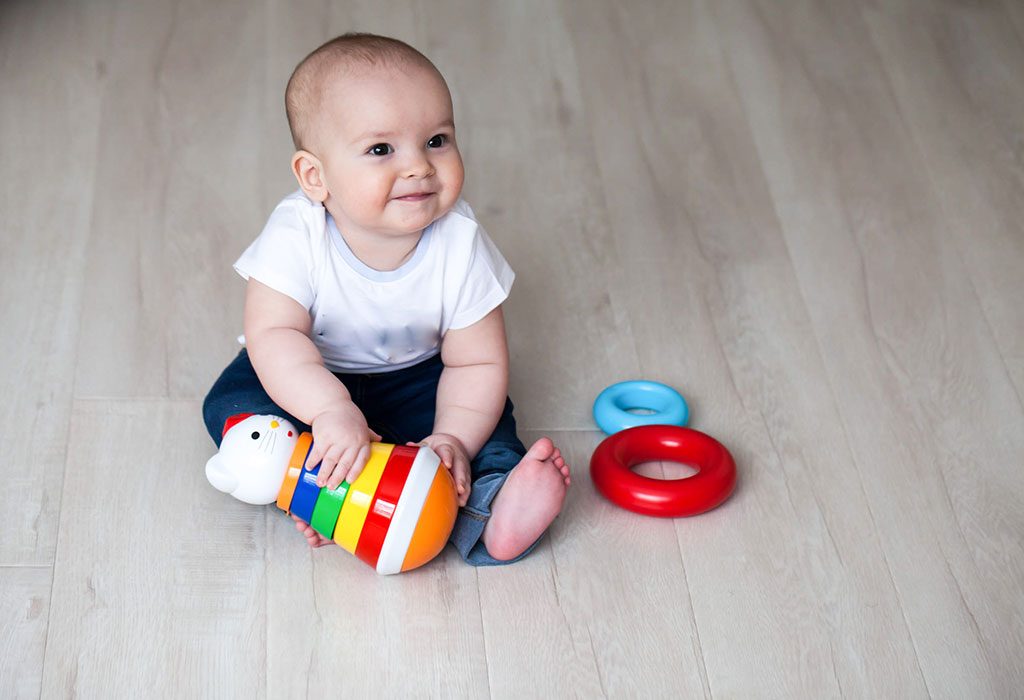
ثبات الأشياء: ما هو ومتى يتطور لدى الرضع
في هذه المقالة
- What is the stability of things?
- Why is the constancy of objects an important concept?
- When does a child develop object stability?
- How did Piaget measure object permanence in infants?
- Stability games
- Signs that your child is developing object stability
- What developments occur after things have settled?
- Frequently Asked Questions
As adults, we understand that things exist, even if we can’t see or hear them, but infants don’t perceive this in the same way. For infants, everything they can’t see or hear fades away from their world, yet their perception and understanding of certain things, even if they can’t see them, is an important stage in their development. This fascinating concept, known as object constancy, plays a crucial role in shaping a child’s cognitive development and understanding of their surroundings, laying the foundation for future learning and exploration.
What is the stability of things?
Object constancy is when your brain recognizes that, even if you can’t see or hear something, it is still there. When your baby is one month old, if you hide something from him or put it away, he thinks it is no longer there. This is because his hearing and sight are still in the early stages of development. Soon, between about 4 and 7 months old, your baby will realize that, even if something is out of sight, it is still there.
Why is the constancy of objects an important concept?
Object stability is an important stage of development. It helps your child understand the world and also learn to anticipate what might happen next. For example, if you hide your child’s toy under the blanket , they will search for it by lifting the blanket. This gives your child the idea that it’s okay for things to disappear sometimes, or that they can let go of something because they can retrieve it later.
Your baby may be frightened by the instability of objects in the first few months. If you move to another room for a while, he may feel scared, believing you’ve disappeared. He feels that what he can’t see is no longer there. As your baby learns about the stability of objects, he also learns that people are still there, even if they’ve left. So, when you come and go, he’ll be fine.
When does a child develop object stability?
Here we will discuss the stages of stability of things, or what is the age of stability of things:
1. From birth to one month: Reflexes
At the newborn stage , your baby understands and explores the world around him through his reflexes. He relies on reflexes, such as sucking, startling, or paddling, to interact with the world around him. However, at this age, your baby doesn’t perceive objects as fixed, but is exposed to visual stimuli, which enables him to sense movement. This is an important stage in development.
2. From one month to four months: Initial circular reaction
Your baby may respond to familiar pictures, objects, or activities, even if only for a few seconds. Your baby may also continue to look at or follow an object for some time. Around this age, your baby’s attention is more intentional than reflexive.
3. From 4 to 8 months: Secondary circular reflex
Around this age, your baby pays more attention to the world around them and may perform actions that elicit their response. During this stage, your baby begins to understand object permanence and may search for partially hidden objects, but not for completely hidden ones. Your baby may pick up visual cues and understand some things, but they do not yet understand more about object permanence.
4. From 8 to 12 months: A stronger sense of exploration
Your child can retrieve objects you hide from them. Although it may seem like a simple task, it represents an important stage in cognitive development . Your child explores objects and becomes more focused on achieving goals, which means their desire to search for objects becomes more deliberate. However, your child may find something you hide in a familiar place and not realize they can find it elsewhere.
5. From 12 to 18 months: Tertiary circular reaction
Around this age, your baby may be able to find an object within his visual field. This means he may only look for something hidden within his visual field, not beyond it. Your baby may do things to attract others’ attention, which is an important milestone for him.
6. From 18 to 24 months: Emergence of object permanence
Around this age, your child has a good idea of the permanence of objects. Your child develops a mental image of objects, which means they may also be able to find hidden objects. At this time, your child will be able to imagine something they cannot see, thus understanding the permanence of objects.

How did Piaget measure object permanence in infants?
Before the introduction of object constancy theory, cognitive development was believed to occur automatically. Psychologist Jean Piaget believed that cognitive development in infants and children is broader and more complex than previously thought. According to Piaget’s theory, infants do not simply sit back and wait for things to happen; rather, they continually strive to understand new information, apply it to their existing concepts, and create their own representations of the various objects around them. Simply put, infants understand and perceive various objects around them by using their motor skills such as sight, touch, movement, and taste.
Initially, infants have no idea about the world around them, believing and understanding only what they see. Therefore, mental representations of various objects become crucial to understanding that things continue to exist even when the eyes cannot see them.
Jean Piaget called these mental representations “schemas,” meaning knowledge of things in the world. For example, a child may have a schema for breast milk or a baby bottle. As your child grows, their schemas multiply and may become more complex. Through the process of adaptation and assimilation, children tend to develop new and different categories by augmenting their existing categories, and they may even change their existing schemas.
Stability games
Infants learn quickly through fun and playful ways, so as parents, you don’t need to overthink teaching your child object permanence. The best way to help your child learn any skill is to spend time with them. There are many examples of object permanence, and through interaction and experiences with parents and loved ones, your child can master various skills and consolidate their learning.
You can buy object survival games or play the following games with your child:
1. Play, leave, come back
This is a great game to play with your toddler. You can simply leave the room, leave your child with your partner or nanny, and return shortly. It’s a great way to teach your child that even if they can’t see you, you’re still there. Object permanence isn’t just about visual perception. You can even call them from the other room to let them know you’re there, even if you’re not visible.
2. Hide and Seek
Hide and seek is one of the best games you can play, as it teaches your child about the permanence of objects. You can play this game with your child between 6 and 12 months old, as by this age they have already grasped the concept of permanence. You can hide behind a curtain or door, show your face to your child, and then hide again. Your child may understand that even though you can’t be seen, you are still there, hidden behind the curtain.

3. Hide your child’s favorite toy.
You can take your child’s favorite toy and hide it under the blanket for a while, then take it out. You can also leave a small part of it visible so your child can find it on his own. You can make this game more interesting and challenging as your child grows by hiding most of the toy and making a smaller part visible. Or you can take the toy and hide it behind you, then bring it out in front of your child.
4. Cup and ball game
Place a small ball or toy under one of the three plastic cups while your child watches. Then mix the cups and ask your child to find the ball. Make the mixing process slow and easy at first, then gradually increase the difficulty as your child’s understanding of object stability improves.
5. Hide and Seek game with moving objects
Take a small toy and hide it in one hand while your child watches. Slowly move your hands behind your back, then bring both hands forward and ask your child to guess which hand is holding the toy. Open the other hand first to create suspense, then reveal the toy. This game keeps your child engaged while reinforcing the idea that hidden objects don’t disappear.
These games are a fun way to ensure your child understands the permanence of objects, but not all children are the same. While some children may enjoy playing these games, others may panic at the mere thought of you disappearing. It’s advisable to handle the situation accordingly. If your child doesn’t react well to these games, stop playing them for a while.
Signs that your child is developing object stability
Object permanence is a key developmental milestone for your child, as it indicates that they’re beginning to understand that things and people continue to exist even when they can’t be seen. Here are some signs that your child is developing this fascinating concept:
- Your baby enjoys playing hide-and-seek, and starts laughing or looking for you when you hide.
- If you hide your baby’s toy under a blanket or pillow, he’ll actively search for it instead of forgetting about it.
- Your baby turns his head or body toward any familiar sound or voice, even if it’s coming from another room.
- Separation anxiety may appear when your child becomes aware of your presence even when he or she cannot see you.
- Your child closely watches a toy or object as it moves out of his or her field of vision.
- Trying to grab or reveal things that you have partially or completely hidden from view.
- Your baby smiles or reacts when seeing pictures of familiar people, even if they aren’t there at the moment.
- Your child begins to expect certain outcomes, such as you reappearing from behind a door or curtain.
- Your child tries to look behind furniture, curtains, or other obstacles to see what is hidden.
What developments occur after things have settled?
Once your child develops object permanence, it marks the beginning of a series of exciting cognitive milestones. Here are some of the developments that typically follow:
- Increased memory and recall: Your child begins to remember familiar people, places, and things, even when they are not present. He begins to recall experiences and show recognition.
- Exploration and Curiosity: With a deeper understanding of object stability, children become more curious about their environment, explore hidden or hard-to-reach objects, and engage in problem-solving activities.
- Understanding cause and effect: As a child begins to realize that their actions can affect the world around them, they begin to explore cause and effect relationships (such as pressing toy buttons to make sounds).
- Improved social awareness: Children begin to become aware of people outside their immediate surroundings, leading to stronger attachment to familiar caregivers and social behaviors.
- Symbolic play: Once a child understands that objects exist outside of sight, they begin to engage in imaginative play, such as pretending objects are something else or using toys symbolically (such as pretending a cube is a phone).
- Better anticipation: Children develop the ability to anticipate events, such as knowing that a game of hide-and-seek is about to happen or expecting you to return after a short separation.
- Language development: As a child becomes more aware of their surroundings and people, they begin to associate words with things, leading to increased vocabulary and comprehension.
- Separation anxiety: A natural consequence of understanding object permanence is that children may experience more distress when separated from caregivers, as they more fully understand the concept of absence and presence.
Frequently Asked Questions
1. Can children with developmental delays understand object permanence?
Yes, children with developmental delays can still achieve the object permanence milestone, although the timeline may vary. It’s important to monitor their progress and consult a pediatrician if there are concerns about their cognitive development. Early interventions can support their learning process.
2. Does the stability of objects affect a child’s attachment to caregivers?
Yes, the development of object permanence is linked to a child’s attachment to caregivers. When babies realize that caregivers are still present even when they’re out of sight, they may feel stronger bonds and possibly greater separation anxiety. This is a healthy part of emotional development .
If you want to know how well your child understands object permanence or have any other questions about his or her cognitive development, consult your pediatrician.
Read also:
Child’s Brain Development – How to Support Healthy Brain Development
Factors Influencing Children’s Growth and Development
Baby Crawling – A Developmental Milestone
Key Stages of Child Development
 فيرست كراي العربية للأبوة والأمومة
فيرست كراي العربية للأبوة والأمومة


